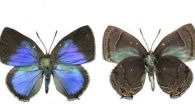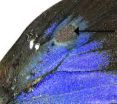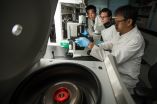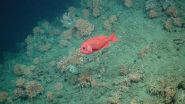To be fragrant or not: Why do some male hairstreak butterflies lack scent organs?
2015-09-16
(Press-News.org) Female butterflies generally choose among male suitors, but in the tropics with hundreds of close relatives living in close proximity, how can they decide which males are the right ones? After all, if she mates with a male of another species, she is unlikely to have surviving offspring. One solution is that males of some species have scent producing organs on their wings, so if a male has the right smell, the female will presumably be receptive to his advances. Strangely, males of some species lack these scent producing organs, which would seem to be a huge disadvantage.
Biologists have theorized that when a species loses a male scent producing organ during evolution, its closest relatives do not occur in the same places. In other words, the female does not have to choose among males of the most closely related species, and the males do not devote energy to producing scents.
A team of researchers, led by Dr. Robert Robbins from the Smithsonian Institution, digs into this question in a small group of Latin American butterflies in a study published in the open access journal ZooKeys. Two newly discovered representatives in this butterfly group possess scent pads while their closest relatives do not. The researchers report that scent pads were lost evolutionarily twice in this group, and as predicted, in each case, the species without the scent pad does not co-occur with its closest relative. The present study adds more evidence to accumulating support for the explanation why some males lack scent pads.
Evolutionary losses, such as the one observed herein in Thereus oppia and related butterflies, are quite common, as Dr. Robbins and collaborators have observed in a previous research. Such disappearances of male secondary sexual features have been explained by geographic isolation of a species from its closest relatives, and the butterflies in this study are no exception.
INFORMATION:
Original source:
Robbins RK, Heredia AD, Busby RC (2015) Male secondary sexual structures and the systematics of the Thereus oppia species group (Lepidoptera, Lycaenidae, Eumaeini). ZooKeys 520: 109-130. doi: 10.3897/zookeys.520.10134
ELSE PRESS RELEASES FROM THIS DATE:
2015-09-16
EAST LANSING, Mich. - Researchers at Michigan State University were part of a team to discover a new natural defense against HIV infection.
The team's discovery, featured in the current issue of the Journal of Biological Chemistry, focuses on ERManI, a protein that prevents the HIV virus from replicating.
"In earlier studies, we knew that we could interfere with the spread of HIV-1, but we couldn't identify the mechanism that was stopping the process," said Yong-Hui Zheng, MSU associate professor of microbiology and molecular genetics and co-author of the study. "We ...
2015-09-16
NEW YORK - September 16, 2015 - EcoHealth Alliance, an environmental health nonprofit organization that focuses on local conservation and global health issues, announced the creation of the first centralized repository to collect data on the biological diversity in Bolivia. EcoHealth Alliance Senior Scientist, Carlos Zambrana-Torrelio, in collaboration with Miguel Fernandez from the German Centre for Integrative Biodiversity Research in coordination with more than 40 Bolivian scientists worked together to create the unique repository. The value of a biological repository ...
2015-09-16
LAWRENCE -- A new study based on longitudinal data confirms a college degree provides an advantage in lifetimes earnings, but a related decision once students make it to college could prove to be even more crucial.
The study that includes a University of Kansas researcher found large lifetime earnings gaps depending on a student's field of study. For examples, men who major in science, technology, engineering and mathematics, or STEM fields, and earning a bachelor's degree achieved roughly $700,000 to $800,000 higher 40-year lifetime earnings from ages 20 to 59 than social ...
2015-09-16
The incidence of the most common strain of Methicillin-resistant Staphylococcus aureus (MRSA) infections has decreased in hospital-onset cases, but has failed to decline in the broader community, according to new research published online today in Infection Control & Hospital Epidemiology, the journal of the Society for Healthcare Epidemiology of America.
The USA 300 strain of MRSA, has become prevalent in both communities and healthcare institutions. "In looking at risk factors for hospital or community-onset USA 300, current or former drug use was a strong predictor ...
2015-09-16
Amsterdam, September 16, 2015 - Targeted cancer treatments, toxicity sensors and living factories: synthetic biology has the potential to revolutionize science and medicine. But before the technology is ready for real-world applications, more attention needs to be paid to its safety and stability, say experts in a review article published in Current Opinion in Chemical Biology.
Synthetic biology involves engineering microbes like bacteria to program them to behave in certain ways. For example, bacteria can be engineered to glow when they detect certain molecules, and ...
2015-09-16
Washington -- A new analysis by the Synthetic Biology Project at the Wilson Center finds the Defense Department and its Defense Advanced Research Projects Agency (DARPA) funds much of the U.S. government's research in synthetic biology, with less than 1 percent of total federal funding going to risk research.
The report, U.S. Trends in Synthetic Biology Research, finds that between 2008 and 2014, the United States invested approximately $820 million dollars in synthetic biology research. In that time period, the Defense Department became a key funder of synthetic biology ...
2015-09-16
The first true three-dimensional picture of submarine canyon habitats has been produced using a unique combination of marine robotics and ship-based measurements. The information captured in this new set of maps ranges in scale from the 200km canyon down to the size of an individual cold-water coral polyp, and will be used to inform the management of the only English Marine Conservation Zone in deep water.
This 'nested map' is the result of a recent scientific expedition to the Whittard Canyon in the Bay of Biscay, led by the National Oceanography Centre (NOC). It works ...
2015-09-16
ROCHESTER, Minn. - Mayo Clinic researchers have identified a protein marker whose frequency may predict patient response to PD-1 blockade immunotherapy for melanoma. An abstract of their findings was presented today at the American Association for Cancer Research International Cancer Immunotherapy Conference in New York City.
"The discovery of biomarkers of sensitivity are vital not only for informing clinical decisions, but also to help identify which patients with melanoma, and possibly other malignancies, who are most likely to benefit from PD-1 blockade," says Roxana ...
2015-09-16
The oil and gas extraction method called hydraulic fracturing remains controversial for multiple reasons, one of which is its water use. But, as scientists report in ACS' journal Environmental Science & Technology Letters, water requirements for the process are potentially lower than those for some other energy-related extraction methods.
Since oil and gas companies ramped up hydraulic fracturing, or fracking, to unlock oil and gas from shale and tight oil formations, reports of earthquakes and contaminated water near wells proliferated. Some environmental experts have ...
2015-09-16
Detecting breast cancer in women with dense mammary tissues could become more reliable with a new mammogram procedure that researchers have now tested in pre-clinical studies of mice. In their report in the journal ACS Nano, they describe injecting gold nanoparticles in mammary tissue to enhance the imaging of early signs of breast cancer.
Mammography remains the clinical gold standard of screening tests for detecting breast cancer. However, a recognized limitation of this X-ray procedure is that dense breast tissue shows up as white masses and fibers on an image, ...
LAST 30 PRESS RELEASES:
[Press-News.org] To be fragrant or not: Why do some male hairstreak butterflies lack scent organs?




